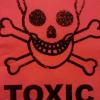OK here you go, a few different method from the old cape Canaveral site
All the chemicals below work by reducing the Chlorate ion. The Sulphites have the same reducing power in dilute acidified solutions as Sulphur Dioxide. All the Sulphite and Sulphur Dioxide reactions take place in a similar manner. You can test for the presence of Chlorate in your product as per US Patent No. 2,392,769
Use K compounds if you need to keep Na out of your final product.
Sodium Metabisulphite
The solution should first be acidified to pH 3 or so using Sulphuric or HCl acid, the Sulphite added and the solution heated strongly or boiled
The Sodium Metabisulphite reactions take place according to:
First, the Metabisulphite dissociates:
Na2S2O5 + H2O <----> 2Na+ + 2H+ + 2SO32-
The Sulphite then reacts with Chlorate:
3SO32- + ClO3 - => 3SO42- + Cl-
The overall reaction is:
3Na2S2O5 + H2O + 2NaClO3 => 3Na2SO4 + 3H2SO4 + 2NaCl
There is more info. here on dissociations.
You can then neutralise the solution using Sodium Hydroxide which will give you more Sodium Sulphate and water.
H2SO4 + 2NaOH ==> Na2SO4 + 2H2O
Sodium Bisulphite
Similar to Metabisulphite
Sodium Sulphite
Similar to Bisulphite
Sodium Disulfite
Similar to Bisulphite
Sulphur Dioxide
See US Patent No. 2,392,769
The chemical equation would be:
SO2 + H2O ===> 3H2SO3 + ClO3 - ===> Cl- + 3SO42-
Sulfur dioxide gas can be generated by a number of means including adding HCl to Sodium Bisulfite and gently heating.
Ferrous Sulphate + H2SO4
This is cheap and easy to obtain. The reaction products should not be a problem. The Sulphate should be dissolved in the acidified water (the acid will stop Iron Hydroxide form forming, it is also necessary for the reaction that destroys the Chlorate) first and then added to the solution that is being treated.
6FeSO4 + NaClO3 + 3H2SO4 ====> 3Fe2(SO4)3 + NaCl + 3H2O
Keep the pH below 3 for the reaction to proceed and the solution should be heated/boiled.
Ferrous Ammonium Sulphate + H2SO4
Same as Ferrous (II) Sulphate but it is more expensive and harder to get. Does not oxidise in air as Ferrous (II) Sulphate does and won't form Hydroxide when added to water. Keep solution below pH 3 for destruction reaction to proceed. Heating or boiling should be used.
Strong acids
HCl is the best acid to use. Wouters page explains the process and is thus:
Acid is added to the solution to be treated and the solution is boiled. Yellow gas is released (the more Chlorate the more gas) as the Chlorate is destroyed.
2KClO3 + 4HCl ===> 2KCl + 2H2O + 2ClO2 + Cl2
This yellow gas is ClO2 and is explosive at concentrations above 10%. It is also very toxic, as is the Chlorine gas, and should not be inhaled under any circumstances. If using HCl, any excess acid can be gotton rid of by boiling. There should not be large amounts of Chlorate present (as with all the other methods) when adding acid. The solution is them basified with NaOH (or appropriate hydroxide or carbonate if you are concerned for the final colour that the produce will make when burned) and the presence of Chlorate should be checked for using some of the sensitive tests for Chlorate. HCl acid can be purchased at the builders providers and is used for cleaning cement
Edited by digger, 20 February 2017 - 06:06 PM.
Phew that was close.














